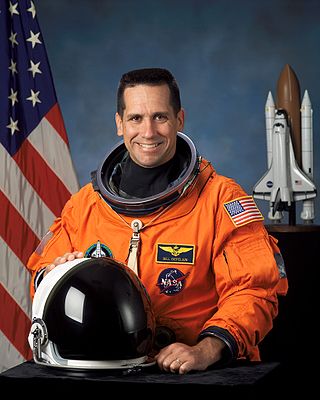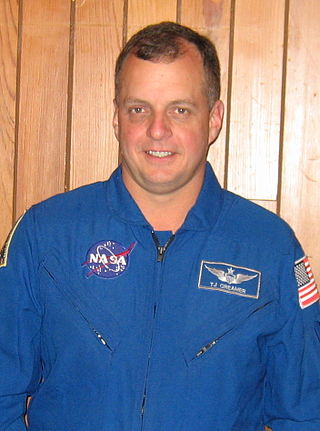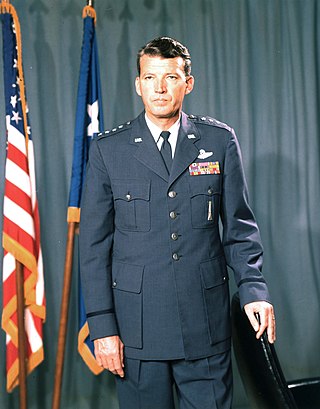
An astronaut is a person trained, equipped, and deployed by a human spaceflight program to serve as a commander or crew member aboard a spacecraft. Although generally reserved for professional space travelers, the term is sometimes applied to anyone who travels into space, including scientists, politicians, journalists, and tourists.

Catherine Grace "Cady" Coleman is an American chemist, engineer, former United States Air Force colonel, and retired NASA astronaut. She is a veteran of two Space Shuttle missions, and departed the International Space Station on May 23, 2011, as a crew member of Expedition 27 after logging 159 days in space.
List of astronauts or space travellers, may refer to:

Piers John Sellers was a British-American meteorologist, NASA astronaut and Director of the Earth Science Division at NASA/GSFC. He was a veteran of three Space Shuttle missions. Sellers attended Cranbrook School, Cranbrook, Kent, United Kingdom, until 1973, and achieved a bachelor's degree in ecological science from the University of Edinburgh in 1976. In 1981 he gained a doctorate in biometeorology from the University of Leeds. In 2011, Sellers retired from the NASA Astronaut Corps.

Carlos Ismael Noriega is a Peruvian-American NASA employee, a former NASA astronaut and a retired U.S. Marine Corps lieutenant colonel.

Charles Joseph Precourt is a retired NASA astronaut. His career in flight began at an early age, and spans his entire lifetime. He served in the US Air Force, piloted numerous jet aircraft, and piloted and commanded the Space Shuttle. Notably, he piloted or commanded several missions which involved docking with the Russian Mir space station and was heavily involved in Russian/US Space relations as well as the International Space Station collaboration. He also served as Chief of the Astronaut Office from 1998 to 2002. He retired from the USAF with the rank of colonel.

Edward Michael "Mike"/"Spanky" Fincke is an American astronaut who formerly held the American record for the most time in space. His record was broken by Scott Kelly on October 16, 2015.

The United States Astronaut Badge is a badge of the United States, awarded to military and civilian personnel who have completed training and performed a successful spaceflight. A variation of the astronaut badge is also issued to civilians who are employed with the National Aeronautics and Space Administration as specialists on spaceflight missions. It is the least-awarded qualification badge of the United States military.

Michael Edward Fossum is a former American astronaut, engineer, and the Chief Operating Officer of Texas A&M University at Galveston. He flew into space on board the NASA Space Shuttle missions STS-121 and STS-124 and served as a mission specialist of Expedition 28 and commander of Expedition 29 aboard the International Space Station.

William Anthony "Bill" Oefelein is an American freelance adventure writer and photographer and former NASA astronaut who, on his only spaceflight, piloted the STS-116 Space Shuttle mission.

Christopher Joseph "Gus" Loria is a retired United States Marine Corps Colonel and a medically retired NASA astronaut. He was originally scheduled to fly on STS-113 as pilot; however, he was grounded from spaceflight due to a severe back injury.

Timothy John "T. J." Creamer is a NASA flight director, retired astronaut and a colonel in the United States Army. Creamer was born in Fort Huachuca, Arizona, but considers Upper Marlboro, Maryland, to be his hometown. He is married to the former Margaret E. Hammer. They have two children.

The National Aeronautics and Space Administration is an independent agency of the U.S. federal government responsible for the civil space program, aeronautics research, and space research. Established in 1958, it succeeded the National Advisory Committee for Aeronautics (NACA) to give the U.S. space development effort a distinctly civilian orientation, emphasizing peaceful applications in space science. It has since led most American space exploration, including Project Mercury, Project Gemini, the 1968–1972 Apollo Moon landing missions, the Skylab space station, and the Space Shuttle. It currently supports the International Space Station and oversees the development of the Orion spacecraft and the Space Launch System for the crewed lunar Artemis program, the Commercial Crew spacecraft, and the planned Lunar Gateway space station.

Michael Scott "Mike" Hopkins is a United States Space Force colonel and a former NASA astronaut. Hopkins was selected in June 2009 as a member of the NASA Astronaut Group 20. He made his first spaceflight as a Flight Engineer on Soyuz TMA-10M/Expedition 37/Expedition 38, from September 2013 until March 2014. He is the first member of his astronaut class to fly in space. Hopkins is the first astronaut to transfer to the U.S. Space Force, participating in a transfer ceremony on the International Space Station. Prior to his transfer, he served over 27 years in the United States Air Force.

Victor Jerome Glover is a NASA astronaut of the class of 2013 and pilot on the first operational flight of the SpaceX Crew Dragon to the International Space Station. Glover is a captain and F/A-18 pilot in the U.S. Navy and is a graduate of the U.S. Air Force Test Pilot School. He was a crew member of Expedition 64, and served as a station systems flight engineer.

Tyler Nicklaus Hague is a United States Space Force colonel and a NASA astronaut of the class of 2013. Selected to be a flight engineer on the International Space Station, his first launch was on Soyuz MS-10, which aborted shortly after take-off on October 11, 2018. His second launch, on March 14, 2019, was successful, taking him and his fellow Soyuz MS-12 crew members to join ISS Expedition 59/60.

The United States Space Force (USSF) is the space service branch of the U.S. Armed Forces. Along with the U.S. Air Force, it is part of the Department of the Air Force, led by the secretary of the Air Force. Its military heads are the chief of space operations, who is one of the Joint Chiefs of Staff, and vice chief of space operations.

SpaceX Crew-1 was the first operational crewed flight of a Crew Dragon spacecraft, and the maiden flight of the Crew Dragon Resilience spacecraft. It was also the second crewed orbital flight launch by the United States since that of STS-135 in July 2011. Resilience launched on 16 November 2020 at 00:27:17 UTC on a Falcon 9 from Kennedy Space Center Launch Complex 39A (LC-39A), carrying NASA astronauts Michael Hopkins, Victor Glover and Shannon Walker along with JAXA astronaut Soichi Noguchi, all members of the Expedition 64 crew. The mission was the second overall crewed orbital flight of the Crew Dragon.

While the United States Space Force gained its independence on 20 December 2019, the history of the United States Space Force can be traced back to the beginnings of the military space program following the conclusion of the Second World War in 1945. Early military space development was begun within the United States Army Air Forces by General Henry H. Arnold, who identified space as a crucial military arena decades before the first spaceflight. Gaining its independence from the Army on 18 September 1947, the United States Air Force began development of military space and ballistic missile programs, while also competing with the United States Army and United States Navy for the space mission.




















